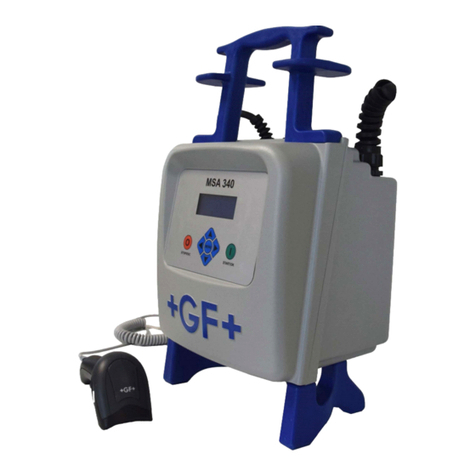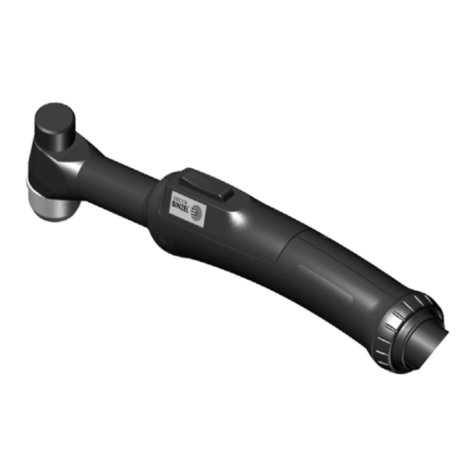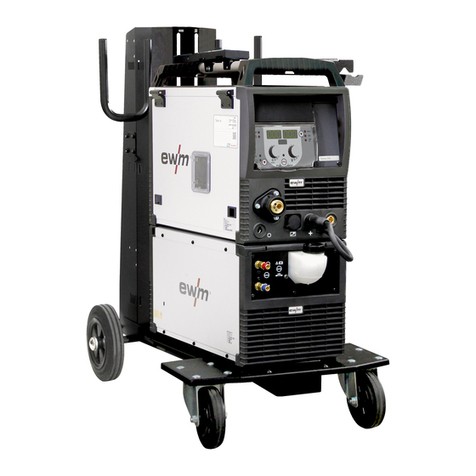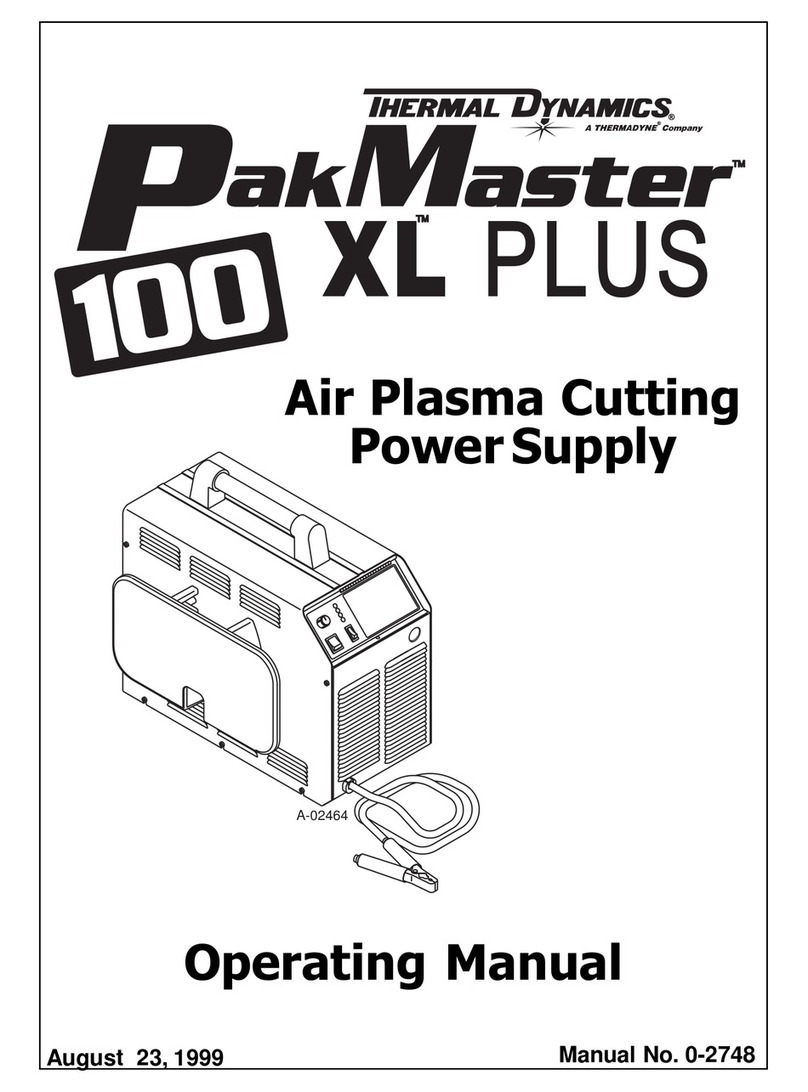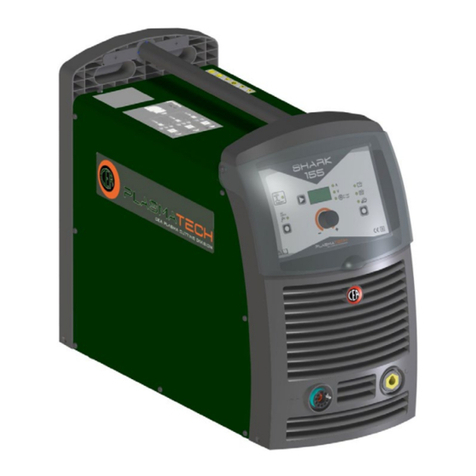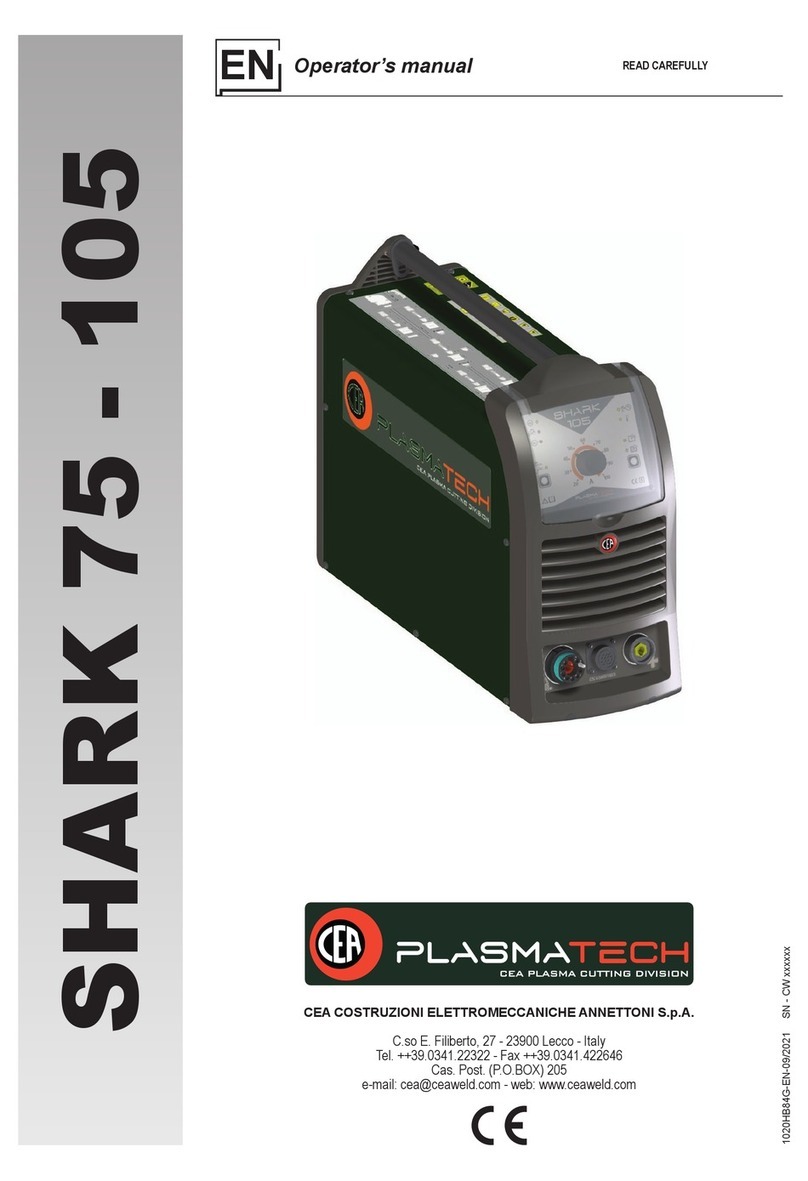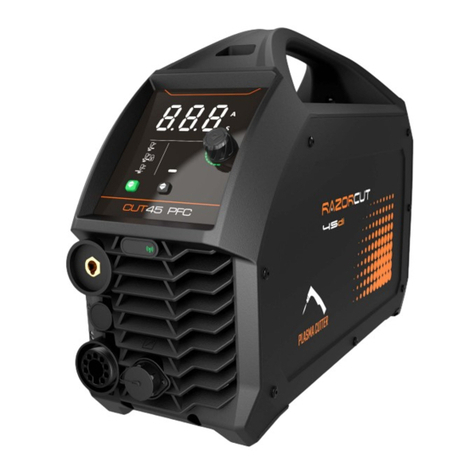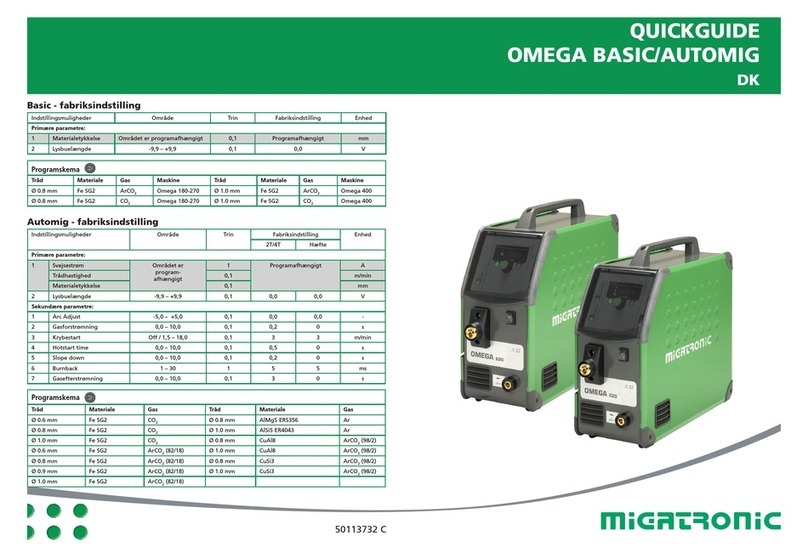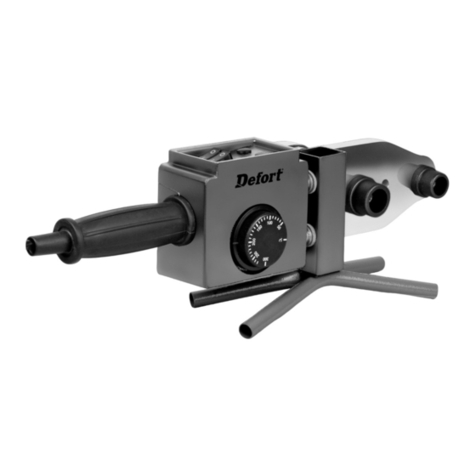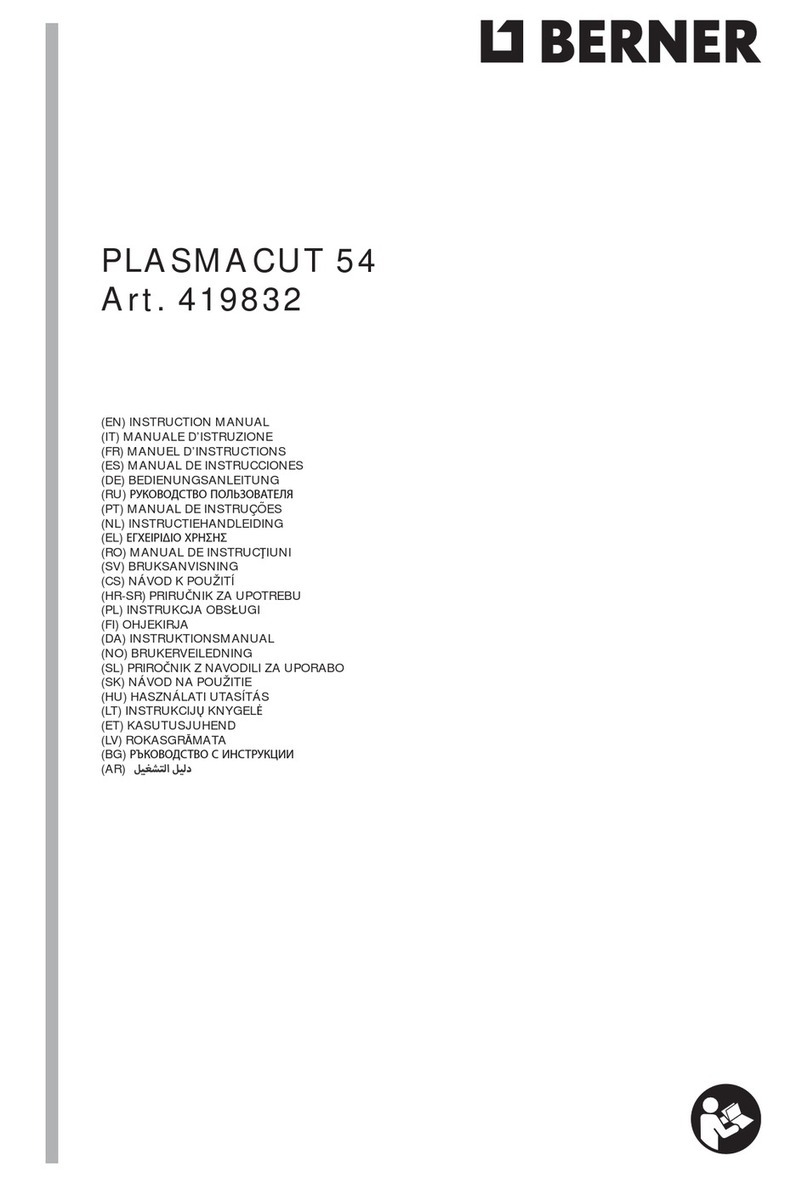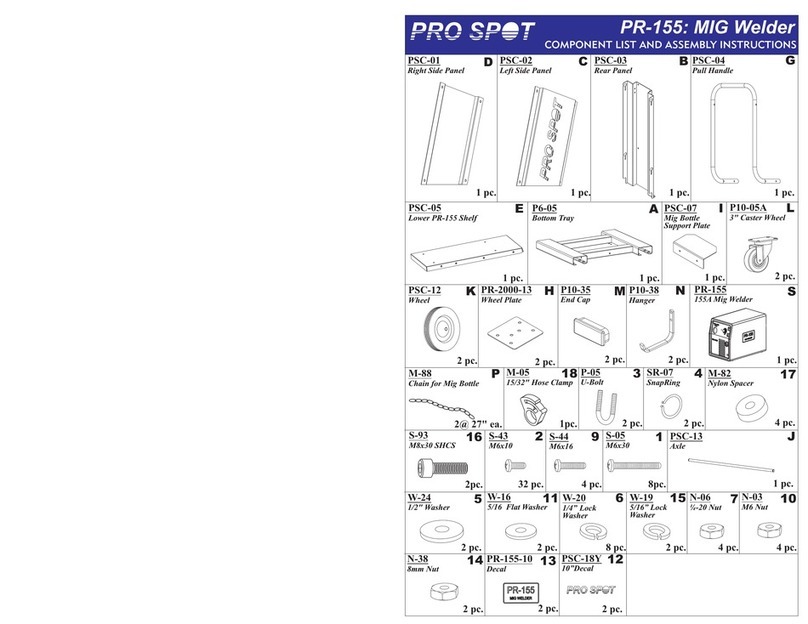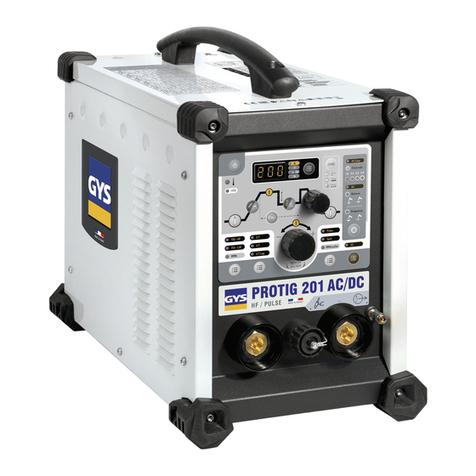
3
Technical data
The technical data for this equipment is summarized in the ta-
ble 1.
Table 1
Model SHARK 45
Single-phase power supply 50/60 Hz V115 ±15% 230 ±15%
Mains supply: Zmax Ω(*)
Power input @ I2Max kVA 4,8 5,5
Delayed fuse (I2@ 100%) A25 16
Power factor / cosφ 0,97 / 0,99
Efficiency degree η0,75 0,80
Open circuit voltage (peak) V460
Current range A20 ÷ 30 20 ÷ 40
Duty cycle @ 100% (40°C) A - 20
Duty cycle @ 60% (40°C) A20 30
Duty cycle @ 35% (40°C) A - 40
Duty cycle @ 25% (40°C) A30 -
Cutting capacity
recommended
maximum
severance
piercing
mm
mm
mm
mm
8
12
15
-
10
15
18
8
Standards
IEC 60974-1
IEC 60974-7
IEC 60974-10
Insulation class IP 23 S
Protection class F
Dimensions mm 595-390-185
Weight kg 15,50
(*) IMPORTANT:
•
This plant meets the requirements laid down in the EN/IEC 61000-
3-12 standard on harmonic currents.
•
This system, tested according to EN/IEC 61000-3-3, meets the re-
quirements of EN/IEC 61000-3-11.
How to lift up the machine
This plant has a handle specifically for carrying the machine
by hand.
NOTE: These hoisting and transportation devices conform to
European standards. Do not use other hoisting and transpor-
tation systems.
Opening the packaging
The standard composition of this plasma cutting system is
made up of:
• SHARK 45 cutting units.
•
Plasma torch with centralised attachment and spare parts kit.
• Earth cable, complete with rapid coupling.
• Neck strap (optional).
• Trolley for transportation (optional).
On receipt of the unit, perform the following operations:
• Remove the plasma cutting unit and all relative accessories
and components from the packaging.
•
Check that the plasma cutting unit is in good condition. If it is
not, inform your dealer immediately.
•
Make sure that all the ventilation louvers are open and that
the airflow is not obstructed.
Plasma cutting
The cutting system used by this equipment is a low current sys-
tem that uses compressed air as its plasma equipment as well
as for cooling. The air normally used is a mixture of 79% nitro-
gen and 21% oxygen. These two biatomic gasses have almost
identical enthalpy and form a highly energetic blend. The low
current also makes it possible to use torches with a low air ca-
pacity and moderate cutting speed, that are more suitable for
manual procedures.
CUTTING PARAMETERS
In analyzing the parameters that characterize manual plasma
cutting it is necessary to note that they depend on the material
to be cut, its thickness and the skill of the operator in following
the cutting line. Optimum speed depends largely on the skill of
the operator and amount of material to be cut and is achieved
when the fused material flows through the groove and is not
projected in the direction of the torch. If the latter occurs, cut-
ting speed has to be reduced.
The parameters that affect cutting are:
•
Electric power. Any increase in electric power will permit
higher cutting speed and greater thickness of the material
to be cut
• Compressed air capacity. Increasing the air capacity ena-
bles cutting thicker material and ensures better quality at
any thickness
•
Distance between hood and piece. The appearance of the
cut and wear of the active components of the torch depends
on the hood being held as a correct distance from the piece.
NOTE: The width of the cutting groove is usually about twice
the diameter of the hole in the hood.
Respect of the above recommendations ensures greatly redu-
ced thermal alterations of the material due to cutting, that are in
any case always fewer than those caused by oxygen torches.
The thermally altered zone is in any case smaller than the zone
on which the weld is effective, so that in welding pieces that
have been cut by plasma it is not necessary to perform any
cleaning or grinding operations.
Installation
The place where the equipment is installed should be selected
with care so as to ensure satisfactory, safe use.
The user is responsible for installation and use of the equip-
ment according to the instructions provided by the manufactu-
rer in this manual.
Temperatures must be between -20°C e +55°C. during tran-
sportation and/or storage in stores.
Before installing the equipment the user should take into con-
sideration any possible electromagnetic problems in the work
area.
In particular, we recommend that the equipment not be instal-
led in the vicinity of:
• Signalling, control and telephone cables.
• Radiotelevision transmitters and receivers.
• Computers or controlling and measuring instrument.
• Safety and protection devices.
If the operator wears a pacemaker, hearing aid or other sim-
ilar device, he should consult his doctor before approaching
the equipment while it is running. The environment where the
equipment is installed must conform with the degree of protec-
tion of the chassis that is IP 23 S (IEC publication 60529). The
system is capable of working in environments where working
conditions are particularly hard.
This equipment cools water by forced circulation of air and must
therefore be positioned in such a way that the air can easily
be drawn in and expelled through the openings in the chassis.
The air must be free of oil, moisture, and other pollutants. Oil
and excessive humidity may cause quick wear on consuma-
bles for the torch, or may even make it impossible to carry out
cutting operations. Other pollutants can cause poor cutting per-
formance and quick wear on consumables.

